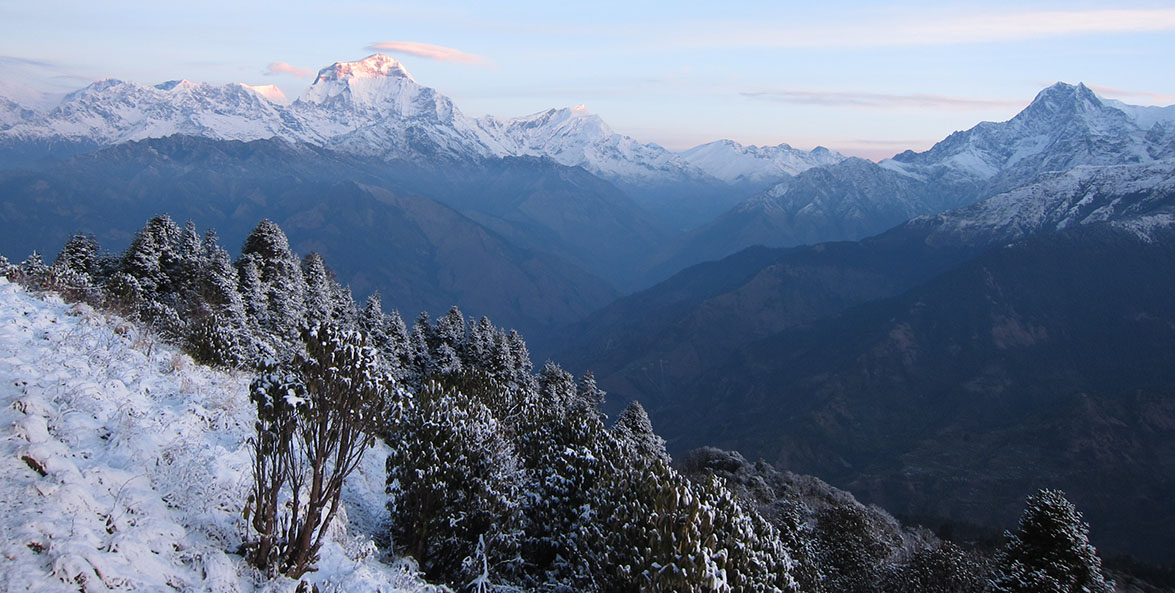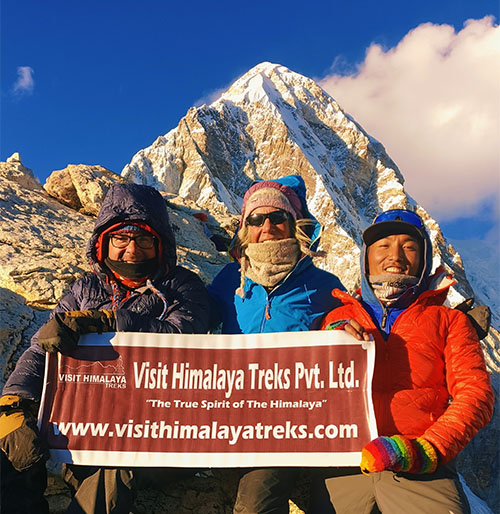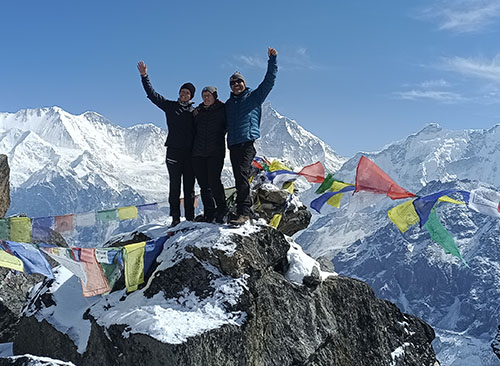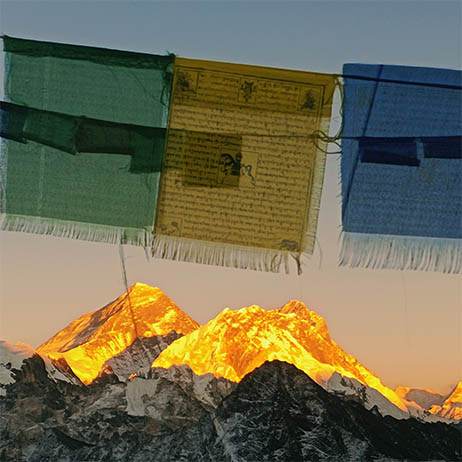Fresh Snowfall
The fresh snowfall during winter transforms landscapes in the mountainous region into breathtaking winter wonderlands. Nepal is nestled within the majestic Himalayan range, so it experiences the ethereal beauty of winter fresh snowfall which creates a magical and serene atmosphere. Snowflakes blanket the rugged terrain, ancient temples, and traditional villages with a pristine layer of glistening white.
You can get stunning and captivating photographs in the snow-covered landscapes, providing excellent photo opportunities. The sight of majestic mountains adorned with a fresh coat of snow is nothing short of awe-inspiring. Winter fresh snowfall is incredibly beautiful and enjoyable. It creates a peaceful ambiance seeing the untouched snow, enhancing the tranquility of the landscape.
Houses are adorned with delicate layer of snow and villages near the surrounding of the towering giants shows its surreal quality. As snow delicately outlines the edges of the carved wooden windows and pagoda-style roofs, a fairytale-like quality emerges. The air is crisp and clear, allowing for unparalleled views of towering peaks that stand as silent sentinels against the wintry sky.
For winter sports enthusiasts, fresh snowfall means optimal conditions for activities like skiing and snowboarding. Some slopes in the area of Mardi Himal Trek, and Pikey Peak Trek allow for a smooth and enjoyable sporting experience during winter. Nepal’s renowned routes are transformed into winter wonderlands, offering opportunities for invigorating treks amid serene and snowy landscapes.
Finally, as the sun rises and sets over the Himalayas, casting a warm and golden hue upon the snow-covered peaks, the sheer magnificence of Nepal’s winter fresh snowfall becomes an experience that etches itself into the hearts of all who have the privilege to witness it.
Touching the snow, be closer to the Himalayas
Touching the snow ignites a sense of wonder and childlike joy that’s rarely encountered in everyday life. It is a moment of communion, a dance of elements, and a celebration of the profound beauty that nature offers. It creates a palpable bond touching the snow and being closer to the Himalayas. This is an incredible way to remind you that you’re not merely an observer but a participant in nature.
Personally encountering snowflakes in the Himalayas goes beyond words and establishes a memorable intimacy with the mountains. Trekking in the higher altitude during winter is an opportunity to make an extraordinary experience, by connecting with the deeper spiritual essence of the mountains. You tap into the timeless rhythm of the Earth by becoming a part of the cyclical process of nature.
Freedom from crowd
Few tourists venture out during winter creating a more peaceful atmosphere and personal interactions with locals. In today’s fast-paced world, many people indeed seek moments of quiet and solitude to rest, relax, and recharge.
Winter treks in Nepal offer quieter trails giving the chance to experience freedom from crowds. It allows you to immerse in the serene beauty of the Himalayas and enjoy a more intimate connection with nature. You can achieve a sense of solitude and tranquility during winter treks than in spring or autumn treks.
Either in popular treks like Everest Base Camp and Annapurna Circuit or the less-popular ones like Mardi and Poon Hill Trek, you’re more likely to meet fewer tourists as the winter months (December to February) is an off-peak season.
Trekkers avoid winter as it brings colder temperatures and icy trails making it challenging to trek. So many trekkers opt for warmer months creating tourist traffic, while winter is left alone for those who seek a break from the noise and demands of daily life.

Dhaulagiri and Nilgiri view from Poon Hill during winter time.
Easy finding accommodation
Finding accommodations in lower trekking regions is more feasible compared to higher-altitude treks during winter. Teahouses, and Lodges in the lower elevation trekking areas such as the Langtang, and Ghorepani-Poon Hill trek are likely to remain open during the winter months.
But, some lodges, and teahouses in the higher regions may be closed due to extremely cold temperatures and reduced visitors. So, accommodation options at ABC, EBC, and other higher altitude trekking can be more limited compared to the peak trekking seasons.
This is why reservations and bookings in advance are required to ensure the availability of service when they’re supposed to remain closed. But, the good thing is you’ll not be required to share rooms with other travelers like in the peak tourist seasons.
Facilities available in the accommodation
Facilities at those accommodations vary widely depending on the trekking region, altitude, and level of development in the area. In popular trekking destinations, the services are competitive, while less-popular ones have very basic facilities available. Accommodation facilities generally include the following:
1. Basic or comfortable beds with blankets or sleeping bags.
2. Availability of sufficient rooms in lodges.
3. Shared or attached bathrooms with squat-style toilets.
4. Hot water showers
5. Communal dining areas
6. Communal heating areas
7. Charging facilities for electronic devices
8. Limited Wi-Fi access
Festivals and Fairs
During winter, Nepal celebrates several significant festivals and fairs that take place in different communities residing in different regions of the country. Nepal is a culturally rich country with a diverse range of festivals and fairs celebrated throughout the year. Here are some notable festivals and fairs that you may encounter in winter and have the unique opportunity to observe praying in temples, witness rituals, and gain insights into traditions:
1. Lhosar
2. Maghe Sankranti
3. Yomari Punhi
4. Holi
5. Christmas Eve
Lhosar: Lhosar is a festival observed by Buddhist Tibetan communities, especially by the Sherpa, Tamang, and Gurung communities of the Himalayan regions. The festival is a celebration of the Tibetan New Year marked by vibrant cultural performances, traditional dances, and rituals. They gather in their traditional attire to perform dances in regions like Solu Khumbu and the Kathmandu Valley.
Tourists have the opportunity to witness and participate in Lhosar celebrations by visiting Buddhist monasteries if they visit Nepal between January and March.
Maghe Sankranti: Maghe Sankranti is observed on the first day of the month of Magh, which usually falls on January 14th. The festival holds cultural and religious significance and is celebrated with various customs and rituals. Devotees visit temples and perform rituals. The festival is associated with eating foods made from sesame seeds, and molasses, and yam-based dishes are prepared.
Tourists have the opportunity to connect with the local culture, witness local markets filled with festive foods and items, and be part of a joyful and festive atmosphere.
Yomari Punhi: ‘Yomari Punhi’ is a traditional food festival celebrated by Newars, with cultural activities in Kathmandu Valley. Newars dress in their traditional attire and perform dances, and prayings in temples in their localities to celebrate this festival, which falls in December or January. As a tourist, you may get a fantastic opportunity for photographs to capture cultural moments and traditional attire. The specialty of the day is the consumption of “Yomari”, a traditional sweet dish prepared to stay together with families.
Holi:
Holi, the festival of colors is an exuberant celebration of spring, love, and the victory of good over evil. It is celebrated by the playful throwing of vibrant colored powders and water at friends, family members, and even strangers. People gather to sing traditional Holi songs and perform dances in the community. Tourists can actively participate in vibrant and colorful celebrations in street festivals and events in major cities. If they visit the country between February and March, it provides a unique opportunity to immerse themselves in centuries-old traditions, making a memorable lifetime experience.
Shivaratri: Shivaratri is a Hindu festival dedicated to Lord Shiva. The festival holds immense cultural and religious importance and is observed in between February and March. Thousands of devotees gather at Pashupatinath temple and conduct special pujas. They often observe night-long vigils, staying awake throughout the night and engaging in continuous prayers and chanting of sacred hymns.
Perfect time to take a Natural Hot Spring
One of the unique charms of winter trekking is the natural hot spring which can indeed be a rewarding and enjoyable experience. Hot springs are usually well-maintained and there are few teahouses and guesthouses around their location.
Immersing in the hot water can be incredibly rejuvenating in chilly winter. You can gain relaxing and therapeutic benefits, making it a perfect way to unwind your trekking in the cold. To cater to your interest, we’ve brought a few of the notable natural hot springs to enhance your winter trekking experience:

Winter Trek to Annapurna Base Camp Nepal.
1. Jhinu Danda Hot Spring:
It is a popular stop for trekkers on the Annapurna Base Camp Trekking route near the village of Jhinu which is easily accessible through trekking routes. It offers the scenery of surrounding landscapes and the Annapurna mountain range.
2. Tatopani Hot Springs in Myagdi:
We’re talking about the hot spring located in the Annapurna region that offers a picturesque view of Kali Gandaki River and the surrounding valleys. The hot spring located in the Myagdi district is easily accessible through trekking routes to Annapurna Circuit or Jomsom to Mukinath Trekking route.
3. Tatopani Hot Springs in Langtang:
The hot spring is located in the Langtang Region, which is reachable by the Tamang Heritage Trail trekking through more remote areas. The journey to the hot spring provides the opportunity to explore diverse landscapes and breathtaking mountain views of the Langtang Himalayan range. You would love to add a unique sense of rejuvenation to your Langtang journey by visiting this hot spring.
Great offers and Discounts
From a financial perspective, winter trekking in Nepal is beneficial for trekkers as it comes with offers and discounts for accommodations, transportation, and other services. Such discounts and offers are unimaginable in peak seasons, while the off-season opens a way to get a discounted price on the negotiation or offers put forward by trekking guesthouses and lodges as a strategy to keep them price-competitive in the area.
Many guesthouses, and lodges in the trekking routes have lower occupancy rates during the winter season. So they offer discounted rates to help maintain a steady flow of income during the slower months. To attract trekkers, they compete and bid their best deals for customers. Off-season, Low occupancy rates provide more room for negotiation leading to cost savings on accommodations, meals, and other services.
Even though you’re not a budget-sensitive type, we recommend winter trekking in Nepal due to the unique perspective of winter trekking and the personalized attention and service from guesthouses, guides, and other service providers, enhancing the overall quality of the trekking experience.
Interact with Nature
Trekking in winter can be a mindful practice due to a quieter and more peaceful environment. The less involvement of the crowd will allow you to fully immerse in nature’s lap, pay close attention to your senses, and deepen your connection with the surroundings. Winter trekking will provide the opportunity to catch the minute details of nature, such as rustling leaves, flowing streams, chirping birds, and occasional chances to spot wildlife.
It’s such a sensational feeling even just to think about what winter trekkers say about stargazing, building snowmen, inhaling the crisp winter air and just walking on the quieter trail. When you could make this imagination come true, your happiness would know no bounds.
Hide and Seek with the sun in the snow
Winter trekking can be a metaphorical game of “hide and seek with the sun in the snow”. It involves a playful interaction between the sun’s rays and the pristine white snow, creating a dynamic and captivating scene. You will relish the brilliant hues of orange, pink, and gold in the snow-capped mountains during sunrises and sunsets.
The interplay of the sun on the snowy surface creates a visually striking and enchanting spectacle. To witness and experience the playful dance of light and shadows amidst a snowy environment is just breathtaking. You’ll discover an exuberant exhibition of beauty and vitality of cold and stillness in winter when illuminated by the sun.
Your adventurous spirit has awakened, hasn’t it?
Conclusion
Winter trekking is characterized to be more peaceful and rejuvenating providing you a much-needed opportunity for introspection and self-reflection in the beautiful nature. It appeals to individuals who enjoy challenges and want to push their boundaries by tracing trails in colder conditions.
Experiencing the hide and seek of the sun in the snow might be another shot of potion to an adventurer and nature lover. The natural hot springs are waiting to give you free therapeutic benefits. What other things are you looking for?
Winter trekking is the absolute way to polish up the dream to create a photo album of grandiose pictures of snowy Himalayas. Other seasons fail to imitate the unique quality that winter provides to the landscape and your experience, so grab your hoodies and take a journey to the mountains, this winter.







